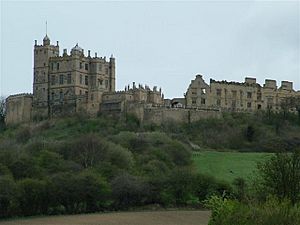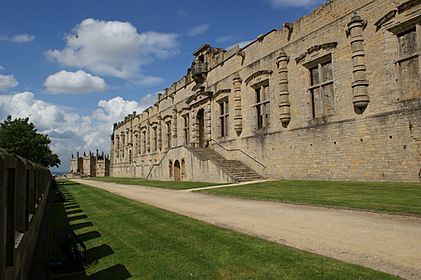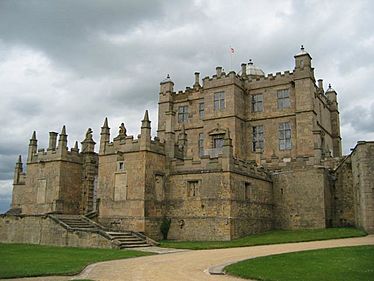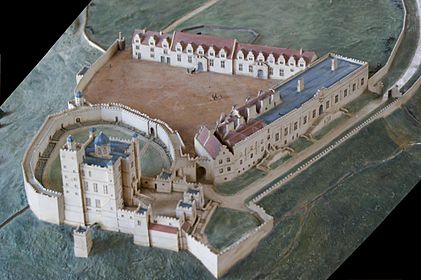Bolsover Castle facts for kids
Quick facts for kids Bolsover Castle |
|
|---|---|

Bolsover Castle seen from below with the Little Castle protruding above the rest of the castle
|
|
| General information | |
| Town or city | Bolsover, Derbyshire |
| Country | England, United Kingdom |
| Coordinates | 53°13′53″N 1°17′49″W / 53.23139°N 1.29694°W |
| Official name: Bolsover Castle | |
| Designated: | 9 October 1981 |
| Reference #: | 1012496 |
|
Listed Building – Grade I
|
|
| Designated: | 23 March 1989 |
| Reference #: | 1108976 |
Bolsover Castle is a cool historic building in the town of Bolsover, in Derbyshire, England. It was built a long time ago, in the early 1600s. This castle stands on the remains of an even older castle from the 1100s! Sir Charles Cavendish started building the first part of the current castle between 1612 and 1617. Today, English Heritage looks after Bolsover Castle. It's considered a very important historical site.
Contents
The Story of Bolsover Castle
The First Castle: Medieval Times
The very first castle at Bolsover was built by the Peverel family in the 1100s. It became property of the King in 1155. The Ferrers family, who were powerful Earls, believed the castle should be theirs.
When King Henry II's sons rebelled against him, the King spent money to make Bolsover and Peveril Castles stronger. He also sent more soldiers, including 20 knights, to protect them.
Later, when King John became king, the Ferrers family still wanted Bolsover Castle. King John eventually gave it to them in 1216 to get their support during a big rebellion. However, the castle's keeper, Brian de Lisle, refused to hand it over.
After a siege, the Ferrers family finally took Bolsover Castle in 1217. But the castle was returned to the King's control in 1223. Money was then spent to fix the damage from the siege. Over the next 20 years, more improvements were made. Four towers were added, and the main tower was repaired. A kitchen and a barn were also built.
From 1290 onwards, the castle was given to local farmers to manage. Because it wasn't used as a strong fortress anymore, the castle slowly started to fall apart.
Building the New Castle: Post-Medieval Times
In 1553, Bolsover Castle was given to Francis Talbot, the Earl of Shrewsbury. His son, George Talbot, was in charge of Mary, Queen of Scots when she was held at Chatsworth House. Some servants at Bolsover were even suspected of secretly helping Mary.
After George Talbot died in 1590, his step-brother, Sir Charles Cavendish, bought the castle ruins. He wanted to build a brand new castle on the site! Charles Cavendish worked with a famous designer named Robert Smythson. Their new castle was made for fancy living, not for fighting. It wasn't finished when both men died in the early 1600s.
Charles Cavendish's sons, William and Charles, continued building the castle. They were inspired by Italian designs. The tower, which is now called the 'Little Castle', was finished around 1621.
A special play called Love's Welcome at Bolsover was performed at the castle in 1634 for a royal visit. But building stopped when the Civil War began in 1642. During the war, soldiers who supported Parliament took the castle. They damaged it badly, leaving it in ruins.
William Cavendish, who became the Duke of Newcastle, fixed up the castle after the war. He added new rooms and made it beautiful again. The family likely lived there for a while. Later, the castle passed to the Bentinck family.
After 1883, no one lived in the castle. In 1945, the Duke of Portland gave Bolsover Castle to the nation. The government helped fix the buildings and opened parts of it to visitors. Today, English Heritage takes care of the castle, and it's a popular place for tourists to visit.
Bolsover Castle Today
Bolsover Castle is a very important historical site. It's protected by law to make sure it stays safe for future generations. It's also known as a Grade I listed building, meaning it's a building of special historical interest.
Some people say Bolsover Castle is haunted! In October 2007, a TV show about ghosts visited the castle. In 2017, the staff at English Heritage even voted it the most haunted site they look after. The TV show Antiques Roadshow also visited the castle in July 2015.
Gallery




